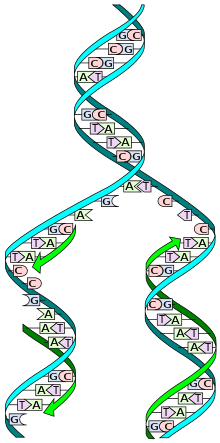Ga: Life
The replicator in virtually all known life is deoxyribonucleic acid. DNA is far more complex than the original replicator and its replication systems are highly elaborate.
Main article: Abiogenesis
The details of the origin of life are unknown, but the basic principles have been established. There are two schools of thought about the origin of life. One suggests that organic components arrived on Earth from space (see “Panspermia”), while the other argues that they originated on Earth. Nevertheless, both schools suggest similar mechanisms by which life initially arose.[29]If life arose on Earth, the timing of this event is highly speculative—perhaps it arose around 4 Ga.[30] It is possible that, as a result of repeated formation and destruction of oceans during that time period caused by high energy asteroid bombardment, life may have arisen and been extinguished more than once.[4]
In the energetic chemistry of early Earth, a molecule gained the ability to make copies of itself — a replicator. (More accurately, it promoted the chemical reactions which produced a copy of itself.) The replication was not always accurate: some copies were slightly different from their parent.
If the change destroyed the copying ability of the molecule, the molecule did not produce any copies, and the line “died out”. On the other hand, a few rare changes might have made the molecule replicate faster or better: those “strains” would become more numerous and “successful”. This is an early example of evolution on abiotic material. The variations present in matter and molecules combined with the universal tendency for systems to move towards a lower energy state allowed for an early method of natural selection. As choice raw materials (“food”) became depleted, strains which could utilize different materials, or perhaps halt the development of other strains and steal their resources, became more numerous.[31]:563-578
The nature of the first replicator is unknown because its function was long since superseded by life’s current replicator, DNA. Several models have been proposed explaining how a replicator might have developed. Different replicators have been posited, including organic chemicals such as modern proteins, nucleic acids, phospholipids, crystals,[32] or even quantum systems.[33] There is currently no way to determine whether any of these models closely fits the origin of life on Earth.
Certain molecules could speed up a chemical reaction. All this continued for a long time, with reactions occurring at random, until by chance it produced a replicator molecule. In any case, at some point, the function of the replicator was superseded by DNA; all known life (except some viruses and prions) use DNA as their replicator, in an almost identical manner (see Genetic code).
A small section of a cell membrane. This modern cell membrane is far more sophisticated than the original simple phospholipid bilayer (the small blue spheres with two tails). Proteins and carbohydrates serve various functions in regulating the passage of material through the membrane and in reacting to the environment.
The prevailing theory is that the membrane formed after the replicator, which perhaps by then was RNA (the RNA world hypothesis), along with its replicating apparatus and other biomolecules. Initial protocells may have simply burst when they grew too large; the scattered contents may then have recolonized other “bubbles”. Proteins that stabilized the membrane, or that later assisted in an orderly division, would have promoted the proliferation of those cell lines.









0 Response to "Ga: Life"
Post a Comment